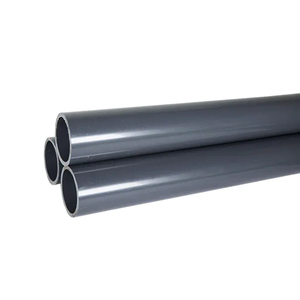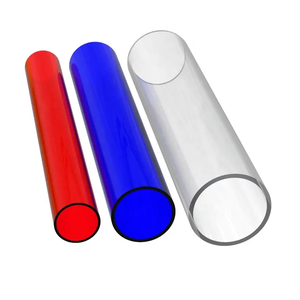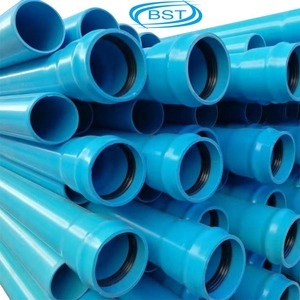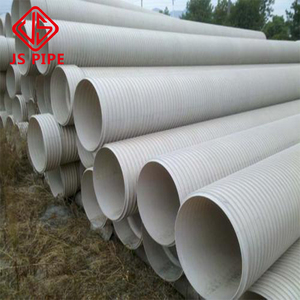(3014 products available)









































































































































































































PVC pipe 630mm is a polyvinyl chloride (PVC) used in plumbing, construction, electrical wiring, drainage, and sewerage projects. This pipe is 630mm in diameter and is widely used in various industries due to its low cost and versatility. Below are the different types of 630mm PVC pipes:
Rigid PVC Pipe:
This pipe is non-flexible and is usually installed underground or in areas where flexibility is not required. Rigid PVC pipes are durable, corrosion-resistant, and have a smooth interior that promotes efficient water flow. They come in various diameters and lengths, making them easy to customize for specific projects. These pipes are easy to install because of their light weight, and they last for a long time.
Flexible PVC Pipe:
Flexible PVC is a good choice when flexibility and ease of installation are important. This is often used for irrigation systems, pool plumbing, and low-pressure water features. Flexible PVC is simple to install in complex arrangements without breaking. It is also resistant to UV rays and weathering, making it an excellent choice for outdoor applications.
Unplasticized PVC (uPVC) Pipe:
This pipe is used for the drainage of waste water and drainage systems because of its corrosion resistance and durability. It is preferred for high-pressure water distribution systems because of its ability to withstand high pressure. This PVC is suitable for underground applications because of its strength and ability to resist soil movement and pressure.
Conduit PVC Pipe:
This type of pipe is used in electrical wiring because of its ability to shield and protect electrical wire from damage and moisture. There are two types of conduit PVC: rigid and flexible. Rigid conduit is used in situations where durability and protection are most important, while flexible conduit is used in areas where ease of installation around corners and obstacles is needed.
Drain-Waste-Vent (DWV) PVC Pipe:
This type of PVC is used in plumbing systems to drain, waste, and vent air. It has a larger diameter and thinner wall than pressure PVC, which makes it lightweight and easy to install. DWV PVC is used to ventilate and drain plumbing fixtures, and its smooth interior surface allows for the efficient flow of waste and vent air.
PVC pipes are commonly used in construction because they have a long life span. They can last for more than 50 years. These pipes are also resistant to corrosion and rust, which makes them a better option for carrying different fluids.
Another important feature of these pipes is that they don't conduct electricity. This is important because it helps to eliminate the risks of electric shocks when people are working near the pipes. They are also lightweight, which makes them easy to transport and install.
The thickness of the pipe helps to ensure that it has a high-pressure rating. For example, a 630mm PVC pipe has a pressure rating of 0.6Mpa, which means that it can handle a pressure of 0.6Mpa. These pipes are available in different pressure ratings, such as:
The 630mm PVC pipe has a wide range of applications, which makes it a popular choice in the construction industry. It is used in water supply systems to transport clean water to different areas like homes, commercial buildings, and agricultural land. The pipes are also used in sewage disposal systems to transport waste water to treatment plants. They are also used in irrigation systems to transport water to crops.
These pipes are also economical. Since they are made of PVC material, they are cheaper compared to other types of pipes. They also require little maintenance, which helps to save costs in the long run. Additionally, they are recyclable, which makes them an environmentally-friendly option.
These pipes have a wide range of applications in various industries and can be used in different scenarios. Here are some common scenarios where PVC-U pipes are used:
Water Supply:
PVC-U pipes are frequently used in municipal water supply systems. They transmit clean water to homes, schools, hospitals, and other public and private facilities. The pipes are preferred for this application because they are durable, corrosion-resistant, and have a smooth interior that allows for efficient water flow.
Sewage and Drainage Systems
PVC-U pipes are also used in the collection and transportation of wastewater and sewage. They are installed in sanitary land drainage and stormwater management systems. These pipes are suitable for this application because they are resistant to chemicals and have the required strength to withstand the pressure of moving wastewater.
Irrigation Systems
PVC-U pipes are used in agricultural irrigation systems to ensure the efficient distribution of water to crops and livestock. The pipes are durable and lightweight, making them easy to transport and install. In addition, they are available in different sizes, thus providing farmers with options that suit their needs.
Electrical Conduit
PVC-U pipes are used as electrical conduits to protect and route electrical wiring. The pipes are preferred for this application because they are non-conductive and can be easily bent and cut to fit various installations.
Telecommunication Networks
PVC-U pipes are installed in telecommunication networks to protect fiber optic cables and other communication lines. The pipes enable the smooth operation of telecommunication networks by providing a safe and efficient medium for cable installation.
Gas Distribution
PVC-U pipes are sometimes used for the distribution of non-corrosive gases like propane and natural gas. They are installed in above-ground and low-pressure gas distribution systems.
Building Applications
PVC-U pipes are commonly used in plumbing systems within buildings. They are installed in hot and cold water supply, as well as drainage, waste, and vent (DWV) systems. These pipes are durable and provide long-term, trouble-free service with minimal maintenance.
Product Application
The most important factor to consider is the pipe's intended use. Different applications have different pressure and material requirements. Ensure the chosen pipe is suitable for the specific application. Consider factors like the type of fluid being transported (water, sewage, gas), the temperature, and the pressure. For example, SDR 21 is ideal for pressurized water delivery, while SDR 26 is better for sewer lines.
Pipe Pressure Rating
The pressure rating indicates the maximum pressure the pipe can safely carry. It's crucial to choose a pipe with a pressure rating higher than the application's maximum pressure to prevent failures or leaks. The rating is determined by the material's strength and thickness. For PVC, this rating is known as the pipe's pressure class.
Geographical Location
The location where the pipe will be used can also affect the type of PVC pipe selected. For instance, areas prone to earthquakes may require flexible pipes, while regions with cold weather may require pipes that won't freeze.
Client Budget
Budget is also an important consideration when choosing a PVC pipe. While it's important to find a pipe that fits within the project's budget, it's also important not to sacrifice quality for cost. A cheaper pipe that fails prematurely can end up costing more in the long run.
Pipe Size
This 630mm PVC pipe is suitable for applications where large diameters are required. This includes irrigation systems, drainage systems, sewage systems, etc. This size is also suitable when more significant water or sewage amounts are needed. Its large diameter allows it to transport more fluid than a smaller pipe. When more significant amounts of fluid need to be transported, using a 630mm pipe is more efficient than a smaller-sized pipe.
Q: What is the lifespan of PVC pipes?
A: PVC pipes have a long lifespan, often exceeding 50 years. They are resistant to corrosion and chemical damage, which contributes to their durability. PVC pipes are also watertight, which prevents moisture from seeping into the ground and ensures their longevity.
Q: What are the disadvantages of PVC pipes?
A: Despite their long lifespan, PVC pipes are less flexible than other materials like HDPE. This rigidity makes them more susceptible to cracking under certain conditions, especially in cold temperatures. Additionally, while PVC is resistant to many chemicals, certain solvents can degrade it.
Q: How can one join a 630mm PVC pipe?
A: Welding is the most effective way of joining the pipes. One can use a pipe welding machine to facilitate the process. Socket welding is another technique that involves inserting the pipe into a socket fitting and then applying heat evenly around the fitting.
Q: Is it safe to use PVC pipes for drinking water?
A: Yes, PVC pipes are safe for drinking water. They are non-toxic and do not release harmful chemicals into the water. Additionally, they are resistant to bacteria and viruses, which helps to ensure the quality of drinking water.